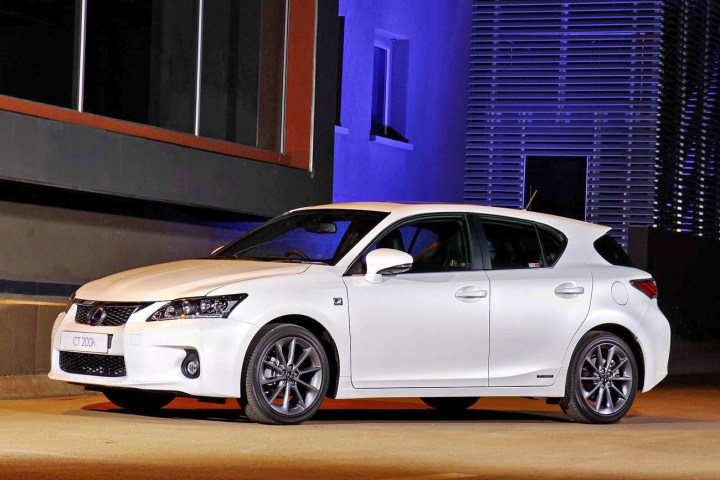Sci-Tech
Lexus CT200h – A hatch that’s eco-cool, not hot

Lexus has come a long way. What started out as an array of smartened-up Toyotas has grown into an independent range of premium models. The brand is also vying for the hybrid high ground. But it’s still considered a bit too fuddy-duddy for younger aspirational buyers. Could its first hatchback change all that? By DEON SCHOEMAN.
I remember the first Lexus I drove. It was a square tank of a car, and about as heavy too, labouring under the weight of hectares of sheet metal, vast expanses of genuine hide and metres of glossy wood veneer.
The portly sedan might have drawn its inspiration from the Mercedes-Benz S-class, but it wasn’t destined to win any beauty titles. However, the one element that made it memorable was the refinement: if ever there was a car with a magic carpet ride, this was it. And the gear changes were so smooth they became imperceptible.
That was way back in the 1990s. Almost two decades later, the Lexus of the 21st Century is a very different car company. It’s still the premium arm of auto giant Toyota, but its range of products reflects an independence and individualism that has added equity and credibility to the brand.
That range still includes a majestic, top-end LS sedan to take on Merc’s S, the BMW 7-Series and the more eclectic Audi A8. There’s also a slightly smaller GS sedan targeting the 5-Series/E-class/A6 segment, and the IS, which would like to entice buyers away from the 3-Series/C-class/Audi A4 spat.

Also in the Lexus line-up is the RX SUV. And except for the IS, all these variants can be had in eco-friendly hybrid versions – a pioneering move that has given those with a green conscience the perceived ability to save the planet from the fast lane.
So far, so good. But the Lexus armour hasn’t been without its chinks. The most obvious shortcoming has been the ability to attract a younger, trendier automotive audience, the kind you see behind the wheels of Audi A3s, or BMW 1-Seres hatchbacks.
In other words, think sporty, compact and aspirational. The brand’s response is a car it’s dubbed the CT200h. In Lexus-speak, the CT is short for Compact Tourer. The ‘h’ confirms the newcomer’s hybrid status.
This is Lexus’ first hatchback, but be warned: as a hybrid, the emphasis is more on economy and efficiency than on hot-hatch driving fun. Instead it’s a cool car for those who like their motoring eco-friendly and luxurious, with a dash of individuality and a bit of dynamic zest.

The CT200h is striking rather than handsome in the conventional sense of the word. It looks better in the metal and even better on the move, but nothing can disguise that heavy rear end.
The version featured here is the F-Sport, which gets a subtle body kit and anthracite-hued 17-inch wheels. The result is some welcome extra aggression. The standard model has slightly simpler lines (which some might actually prefer) and smaller, 16-inch alloys, which simply look too small for the wheel arches they’re trying to fill.
The front end bristles with aggression, thanks to slanted headlights, the meshed grilles of the upper and lower air intakes and a deep, integrated bumper with space for the standard fog lamps.
A strong shoulder line emphasises the CT200h’s wedged profile, while the sloping roofline suggests slippery aerodynamics. As mentioned, it’s the tail that lets the side down: the haunches are simply too pronounced and the tailgate too abrupt.

Even the stylised rear apron can’t save it from looking heavy-set and clumsy. But it does stand out from the luxury hatchback crowd. And yes, it does attract attention. Mission accomplished then.
One of the things Lexus does particularly well is interior design and that also goes for the CT200h. The execution is smart and upmarket, with leather upholstery and a tactile sense of quality. There’s also an element of high-tech appeal which suits the car’s personality.
For instance, the instrument panel changes depending on the drive mode selected. In “Sport”, the backlighting turns an angry red, and the econometer is replaced with a rev counter.
The front bucket seats are cushy and comfortable, but the rear is more cramped than expected, due in part to the rear-sloping roofline. Luggage space is modest at best, though, and you’ll need to fold the split rear bench seat down to accommodate larger items.

Up front, the dashboard features a pop-up colour display that provides access to a host of information. Select reverse gear, and it shows an image with parking guidelines from a tiny camera above the number plate to make sure you don’t bump anything.
You also use it as an interface to set up and operate the CD audio system and the Bluetooth telephone interface, as well as the turn-by-turn navigation system. USB and auxiliary inputs allow the use of iPods and other personal music devices.
You can monitor the hybrid drivetrain via a graphic on the display that shows the energy flow between the engine, the electric motor, and the battery. Think Battlestar Galactica with a twist of automotive realism, and you’ll get the general idea.
The Premium Pack (also fitted to our test car) added a 10-speaker premium sound system, the colour display, the navigation, the reverse camera and voice command functionality. The pack ads almost R36K to the asking price.
To Lexus’s credit, it’s all pretty intuitive and user-friendly. There’s no need to frantically page through a badly translated operating manual.

Which brings us to what’s lurking under the CT200h’s bonnet. As the ‘h’ badging has already confirmed, the new Lexus hatch is powered by a hybrid drivetrain that combines a 1,8-litre VVT-I petrol engine with an electric motor.
The four-cylinder unit is good for 73kW of power and 142Nm of torque. The electric motor is rated at 60kW and 207Nm. However, you can’t add up the two to calculate total system output. Combined output is 100kW.
The drivetrain uses a CVT gearbox to transfer power to the front wheels. And that’s perhaps the most disappointing aspect. It’s operated via a fiddly, stubby little gear lever that sprouts from the dash. And it doesn’t offer any sequential manual mode, let alone shift paddles.
Thus, you’re left at the mercy of the gearbox’s whims. A CVT (Continuously Variable Transmission) uses a pulley system with a belt running over two cone-shaped pulleys to create continuously variable ratios.

The design is more efficient than a normal gearbox, but because engine revs bear little relation to road speed, it sounds as if the clutch is slipping, which can be both annoying and disconcerting. Besides, without the discipline of swapping between ratios, real or simulated, some of the car’s ability to engage the driver is lost.
The CT200h offers several driving modes. The default is “Normal”, but you can also choose “Sport”, which adjusts the throttle, steering and stability control to more aggressive settings. Then there’s “Eco”, which optimises economy. And, if there’s enough battery power, you can choose pure electric mode – or as we like to call it, stealth mode.
With a full battery, the Lexus will cover up to 3km in silent, zero-emissions mode, as long as you don’t exceed 40km/h. Good for the stop/start drudgery of a traffic jam, but not exactly practical in less congested environments.

Not surprisingly, “Sport” mode was my defaults setting. And even then, this sporty-looking CT200h doesn’t become a surprise member of the hot hatchback club.
The crisper throttle response and meatier steering add some welcome driving appeal. But manual shifting is always and sorely missed. No wonder that performance is best described as brisk, with a 10.1sec sprint time from zero to 100km/h and a 180km/h top speed.
If you want impressive statistics, you’re better off examining the fuel consumption and emissions figure. Lexus claims a combined-cycle consumption figure of just 4.1litres/100km, which should allow it to dip into the threes at constant, open-road speeds.
The CO2 emissions figure of 94g/km is way under the 120g/km tax threshold, underlining just how efficient (and eco-friendly) the drivetrain of this CT200h actually is.

The chassis remains somewhat underutilised. It’s equipped with a classy, all-independent suspension consisting of MacPherson struts up front, and race-bred double wishbones at the rear. The damper settings are tuned for comfort, but still provide a reasonable idea of the poise and response on offer.
The electric power steering lacks the mechanical feedback and inertia of a conventional system, but in “Sport” mode, more heft is added to the turn-in, which makes threading the Lexus through the twists and turns of a Cape mountain road a somewhat more rewarding experience.
The Lexus CT200h adds another string to the Lexus hybrid bow, and one that will appeal to a younger, tech-savvy, eco-conscious audience. It’s also the most affordable Lexus hybrid to date and should broaden the brand’s horizons as a result.

However, cheap it’s not. At R343,300, the CT200h is aimed squarely at the A3/1-Series sector. Add the F-Sport package with all the bells and whistles, and the price starts nudging R400,000. The extras on our test car pushed to R434,200.
So, to really enjoy this new Lexus hatchback, you’ll need to be a true believer in the hybrid concept – as well as the benefits and the limitations that hybrid technology entails.
It’s a brave effort that will no doubt find a welcoming niche. But the petrolhead in me is hoping the CT200h is only the first instalment of a Lexus hatchback programme that will spawn something more conventional, and a lot more athletic, in the years to come.
After all, with RS3s and 1-Series M models already in the mix, surely performance-hungry Lexus hatchback buyers deserve something a bit more rapid? DM
KEY STATS
Lexus CT200h F-Sport Premium Pack
Engine
1,798cc four-cylinder petrol plus electric motor
Gearbox
CVT
Power
73kW @ 5,200rpm (petrol); 60kW (electric). Total = 100kW
Torque
142Nm @ 2,800rpm
0-100 km/h
10.1sec
Top speed
180km/h (governed)
Fuel consumption
4,1 l/100km (combined cycle)
CO2 emissions
94g/km
Retail price
R434,200





 Become an Insider
Become an Insider